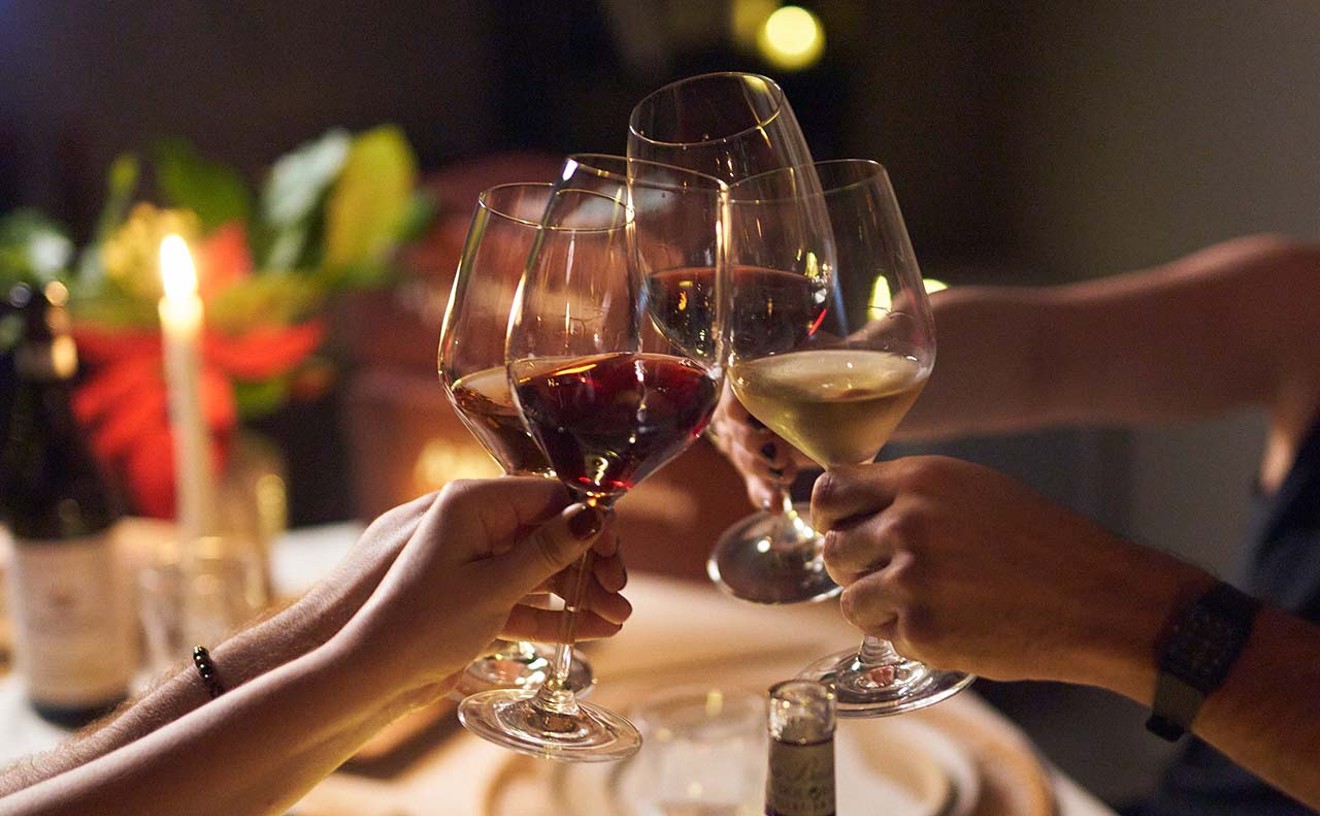The old-world opulence of Palme d'Or seems especially anachronistic in the patently lax 21st Century. The 70-seat space, a restored homage to the original 1926 Biltmore Hotel restaurant, is a bygone world of ceiling frescoes, crystal chandeliers, intricately carved woods, black-and-white photos of vintage movie stars, and an almost fun-house abundance of mirror-covered columns throughout the room. (Choice tables are toward the rear, facing the alluring aqua gleam of the swimming pool, but you need to request one of these when making reservations.) Yet as archaic as Palme's setting is, the cuisine is firmly anchored in the here and now — and, wow, is it good.
Chef de cuisine Philippe Ruiz has been at the helm for ten years. Originally from Saint-Julien-en-Genevois, France, Ruiz has accumulated all sorts of serious accolades, most notably the Chevalier de L'Ordre du Mérite Agricole (said to be even more prestigious than being a judge on Top Chef). Over the past decade, his plates have become "smaller" and comparably less pricey, while his Spanish influences have grown more pronounced (gazpacho, Ibérico ham, Rioja reductions, and so forth). Palme's menu descriptions foreshadow the distinctiveness of the cuisine to come: Smoked Pinot Noir reduction with roasted monkfish cheeks? Haven't seen that pairing before, nor salted butter and coriander buttressing caramelized hake. And yet, as alluring as these sounded, the tastes proved even sounder.
The seasonally changing bill of fare is extremely user-friendly: One salad, four soups, and a half-dozen appetizer-like plates are listed together for $14 each. Page 2 encompasses six seafood selections ($18) and five meats ($20). The waiter and menu both recommend "three to four" plates per person; three apiece will most assuredly be enough. If you have trouble mixing and matching, there are prix fixe menus that do so for you: vegetarian (four courses for $56), seafood (three for $60), Provençale (three for $52), and Le Menu de Philippe, a five-course deluxe affair for $100.
Two courses (plus dessert) might even suffice if you eat all three freshly baked rolls placed on your plate (mini baguette, whole wheat, and walnut) — and then nab another couple when the bread server comes around again later (butter, it should be noted, is served in an appropriately softened state). Diners are also treated to an amuse-bouche — on one visit a petite cup of shredded beef suspended in gelatin and capped with a horseradish-grain mustard foam. Another time, it included a perfect, silky minted pea purée laced with strips of smoked salmon that left me craving a whole bowl.
Instead, I started with memorable morel soup musky with that spongy mushroom's earthy aroma and elevated by crisp nuggets of sweetbreads, roasted shafts of asparagus, and a cappuccino-like cap of foamy cream. Gazpacho was showier if not quite as impressive. The waiter poured a smooth coral-colored purée based with vine-ripened tomatoes atop a dazzling garnish of red piquillo peppers, white bits of fresh goat cheese, a pearl onion, a roasted garlic clove, and a crouton surrounded by a glowing green ring of cucumber jelly.
Two thin circles of applewood-smoked salmon form the "pastry" layers of a cylindrical napoleon of Dungeness crab. The sweet, shredded shellfish, brightened by lemon oil vinaigrette, played against salty notes from the salmon and a dab of Osetra caviar on top, to delectable effect. Yet the standout of the opening selections was a large, soft, plump, juicy Maine scallop. The bulging bivalve arrived royally draped in fat-streaked shavings of Ibérico de Bellota ham culled from the famous pata negra pig (that until recent years was not allowed for import into the States). The $7 supplemental charge is no doubt based on the recherché chestnut-flavored pig carrying a per-pound price rivaling that of diamonds, but don't let cost deter you (assuming this offering remains on the upcoming fall menu). Organic micro sprouts, fresh fava beans, green olives, and rounds of spicy chorizo sausage, all dotted with basil oil vinaigrette, rounded out the mind-boggling montage of flavors.
It is difficult to imagine a follow-up course that can compete with the scallop, but the aforementioned monkfish cheeks in smoked Pinot Noir reduction did just that. The succulent fish came sumptuously bedded on a veritable garden of vegetables: beets, asparagus, carrots, morels, and baby pattypan squash. That caramelized hake with salted butter and coriander also hit the mark — the moist square of fish blanketed with a ragout of carrots, celery, peppers, tomatoes, and artichoke hearts.
Beef "effilochée" was effing delicious. The cylindrical castle of shredded shank meat is braised for seven hours and crowned with organic micro sprouts sprayed with truffle vinaigrette. Surrounding the meat are concentric moats of red wine reduction sauce and potato mousseline, the latter so soft as to seemingly lack molecular structure. A disk of duck is plated in similar fashion — the shredded confit meat in the center of the plate encircled by morels, asparagus, and potato mousseline and encased in a crystalline-thin phyllo wrap, an effectively lighter substitute for the classic French pastry dough that Ruiz must have used in his younger days.
Likewise luscious was farm-raised lamb, fanned slices of herb-rimmed Riverview Farm tenderloin in a glossy reduction sauce teased with garlic and thyme. A triangle of grilled polenta and a zucchini flower filled with teenily diced ratatouille share the plate, making it hard to believe this was just $20.
Olivier Rodriguez took over as pastry chef a year ago, and there is no letup come dessert course — which, like the preceding ones, stylistically stretches from classic French to imaginative global without missing a step. The former: a warm, weightless chocolate soufflé that released steam as the waiter poked a hole in the center and poured velvety chocolate sauce into it. The latter: a shallow bowl of cool coconut broth buoyed by ginger and lemongrass and bolstered with diced lychees, raspberries, kiwi, mango, papaya, and a quenelle of jasmine rice sorbet that dissolved in the mouth like mist.
We closed our meal with glasses of a 2006 Côteaux du Layon, a distinctive dessert wine with a heady nose and complex honey and mineral notes (from Clos du Pavillon in the Loire Valley). Veteran restaurant manager and sommelier Sebastien Verrier is peerless in matching cuisine with appropriate picks from the extensive and worldly wine list. And service was super. The well-schooled dining room staff displayed textbook etiquette and seemingly materialized from thin air anytime we needed them.
To sum up: There should never be a conversation about Miami's best chefs that does not include Philippe Ruiz, nor one concerning our finest restaurants without mention of Palme d'Or.











